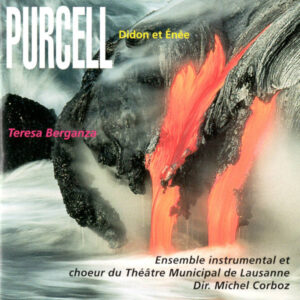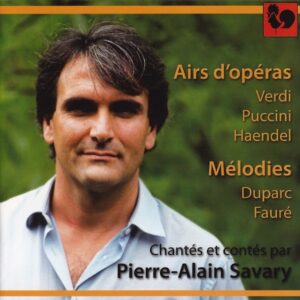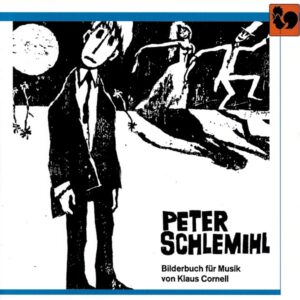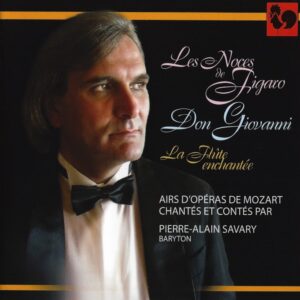Extraits / Excerpts
Domenico Cimarosa: Il Matrimonio Segreto (Live) - Elzbieta Szmytka - Jeannette Fischer - Anne-Marie Owens - Orchestre de chambre de Lausanne, Jesus Lopez Cobos
Domenico CIMAROSA: Il Matrimonio Segreto
CD 1:
Il matrimonio segreto: Overture – Act 1: Cara, non dubitar – Act 1: Lusinga, no, non c’è – Act 1: Io ti lascio, perché uniti – Act 1: Ecco che qui sen vien – Act 1: Udite, tutti udite – Act 1: Signora sorellina – Act 1: Le faccio un inchino – Act 1: Chetatevi e scusatela – Act 1: E vero che in casa – Act 1: Prima che arrivi il Conte – Act 1: Senza, senza cerimonie – Act 1: Certo sarete stanco – Act 1: Sento in petto un freddo – Act 1: Più a lungo la scoperta – Act 1: Signor, deh, concedete… – Act 1: Oh, Carolina! La sorte è a me propizia – Act 1: Perdonate, signor mio – Act 1: Tu mi dici che del Conte.
CD 2:
Il matrimonio segreto, Act 2: Questa invero è curiosa! – Act 2: Se fiato in corpo avete – Act 2: Ecco che or ora scoppia da sè la cosa – Act 2: Sento, oimé! che mi vien male – Act 2: Vanne, vanne, la seguita… – Act 2: Pria che spunti in ciel l’aurora – Act 2: Qua nulla si conclude – Act 2: Son lunatico, bilioso – Act 2: Ebben? Sei persuasa di rinunziare – Act 2: Cosa farete? – Act 2: Dunque andrà in un ritiro – Act 2: Come tacerlo poi – Act 2: Dove, dove mia cara – Act 2: Deh! lasciate ch’io respiri – Act 2: Sarete or persuasa… – Act 2: Se son vendicata… – Act 2: Venite qua, Paolino – Act 2: Il parlar di Carolina – Act 2: Deh, ti conforta, o cara.
Carolina: Elzbieta Szmytka
Elisetta: Jeannette Fischer
Fidalma: Anne-Marie Owens
Paolino: Tracey Welborn
Compte Robinson: François Le Roux
Geronimo: Angelo Romero
Alain Marcel, Staging – Véronique Carrot, Harpsichord.
Orchestre de chambre de Lausanne, Jesus Lopez Cobos, Conductor.
Il Matrimonio Segreto
On February 7th, 1792, at the Vienna Burgtheater, the enthusiasm of the public and of their sovereign acclaimed the most spectacular success which an opera had ever known. The work so honoured was a comic opera in two acts by Domenico Cimarosa, The Secret Marriage. At the end of the performance, the new Emperor Leopold I, who had commissioned the work, offered a copious meal to the troupe and asked for a second entire performance! By this most unusual request the Emperor, who wasn’t known to be very musical, meant perhaps to underline the difference between himself and the cultured patronage of his predecessor Joseph II. New Emperor, new music! Mozart had just passed away, Haydn had comfortably settled in London and Salieri had left the direction of the opera. By good fortune, Cimarosa happened to be in Vienna where he was able to take advantage of the situation.
Domenico Cimarosa, born in 1749 in Aversa, of a modest background, had been exercising his art for a long time in the Neapolitan theaters before reaching notoriety in Rome, in 1779, with his Italiana in Londra. With his reputation firmly established, he undertook a journey to St. Petersburg, like so many other composers of his time, notably Paisiello and Sarti. But the Russian climate, by any standard not very sunny, did not inspire him much, and his three theatrical works – La Felicita Inaspettata, Cleopatra and La Vergine del Sole – did not bring him the consideration he hoped for. After four years of mutual misunderstanding, Cimarosa left the Tzar’s court and, on his way back to Italy, he stopped in Vienna.
Upon his arrival, and in order to fulfill the commission of a comic opera, he sets to work with the “librettista cesareo” Giovanni Bertati. “Bertati is a fool. He is composing an opera for Cimarosa but he is beneath such an honor” . These unkind and bitter words were written by Lorenzo da Ponte, who, compelled to leave Vienna, paid a first and last visit to his successor. The interview, as he tells it in his memoir, was icy and short but gave him just enough time to notice, on the poet’s desk, a “French comedy” which became the source for The Secret Marriage. This was probably either a sentimental drama by Madame Riccoboni called Sophie or the Hidden Marriage, or Joseph-Alexander Pierre’s The Clandestine Marriage. These borrowings are the last links of a thematic thread which goes back to William Hogarth’s pictorial cycle The Fashionable Marriage, which is a clear, merciless parable about the dramatic consequences of a marriage arranged between a rich “bourgeois” and a penniless nobleman. In 1766, George Colman and the actor David Garrick based a comedy on it which rapidly gained success around Europe, giving birth, in turn, to many adaptations: in the Clandestine Marriage, the “honourable merchant sacrifices his daughter’s happiness to the vanity of an empty title”.
In Cimarosa’s version, there is no question of a dramatic end; the determination of the children, Paolino and Carolina, overcomes the vanity and covetousness of their parents.
Contrary to his contemporaries, Cimarosa adds to this text, free of sentimental or ideological redundancies, a music which avoids any mechanical process. Through an infinite variety of rhythms and melodies, often unexpected, he suggests a thorough musical reading of a domestic episode which finds its solution in an atmosphere of gentleness, without violence or fuss: a story free of any critical dimension, but affectionate and slightly ironical.
Only a few months after Mozart’s death, we are already far from the theme elaborated in Le nozze di Figaro, Don Giovanni or Cosi fan tutte, which is more complex and ambitious, and which offers an infinity of varied readings through a veritable spectrum of the characters. Mozart, though, is not absent from Cimarosa’s world; even the terrible reviewer Eduard Hanslick recognized the fact that: “Between Le nozze di Figaro and Il matrimonio segreto there is a secret marriage.” While Le nozze are present in the organization of certain scenes, The Magic Flute is cited at the outset in the first three chords of the overture.
The deserved success of the work rapidly made it an indisputable reference, and from then on, marks of affection and esteem were never lacking. The testimonies of Rossini, Goethe, Schumann, and Verdi are just a few examples amongst many.
In a discography which has hitherto ignored the importance of this opera, the recording of The Secret Marriage made in 1992 during performances at the Theatre Municipal de Lausanne at last permits recognition of its theatrical and musical value. With the advantages of a live recording and without the artificial technique of a studio, the work is given here with all the spontaneity and vivacity of a “real musical comedy,” as Verdi liked to put it.
Sandro Cometta
- Categories
- Composers
- Interprets
- Booklet












